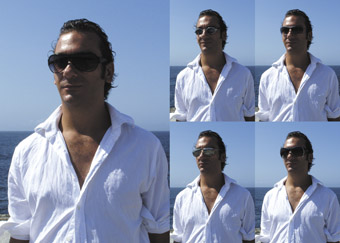the time consumers
danni zuvela mingles with goma’s leisure class

Justine Cooper, Havidol series (2007)
courtesy of the artists
Justine Cooper, Havidol series (2007)
A SHOW THAT WANTS US TO THINK ABOUT CONSUMPTION HAS ITS WORK CUT OUT FOR IT. IT’S TO THE CREDIT OF BRISBANE’S GALLERY OF MODERN ART’S SUMMER MOVING IMAGE SHOW, THE LEISURE CLASS, THAT IT MAKES US WANT TO.
While downstairs, to the regular ‘ka-ching’ of the gift shop cash registers, the Andy Warhol machine churned away profitably, upstairs, the media gallery housing The Leisure Class was the stage for a more reflective nexus of art, consumption and contemporary culture. Inspired by foundational anti-consumerist Thorstein Veblen’s 1899 influential monograph, Theory of the Leisure Class, the show comprises a tight selection of video art, performance documentation, animation and a short cinematheque program.
In Aernout Mik’s Pulverous (2003), a team of dead-eyed artworkers engage in a slow-motion ballet of product wreckage. These scenes of supermarket destruction are a perfect, unabashedly literal playing out of Veblen’s concept of ‘conspicuous waste’ which typifies the leisure classes. The psychogeography of the supermarket is targeted by a number of other artists in The Leisure Class. It’s hard not to smile at the deadly serious expression on Christian Jankowski’s face in his video Die Jagd (The Hunt; 1992/1998) as we watch the artist conduct his self-appointed quest to eat only food that he shoots on the supermarket shelves with a bow and arrow.
A more sustained grocery attack is found in French artist Mathieu Laurette’s project Apparitions: Money-Back Products (1997), an installation displaying the outcomes of that artist’s successful scamming of products, vouchers and reimbursements intended for unsatisfied consumers of branded goods. Laurette himself presents as a playful trickster character; we see him on French daytime TV, cheerfully relating to an eager media the strategies of deception which enabled him to live entirely on dubious gains. What is most interesting about this performance documentation is the reaction of the national media: French television, perhaps sensing a kinship with the artist’s methods (if not his ideals), seems more interested in his processes than troubling themselves with any difficult questions about the morality of his (essentially dishonest) project. Laurette’s work must of course be seen in conversation with that of the acknowledged patron of French anti-consumerism, Guy Debord, whose seminal film work, Society of the Spectacle (1973) features prominently in the show and, as the 40th anniversary of May ’68 approaches, seems more relevant than ever.

Lilly Hibberd, Endless Summer (2007)
courtesy of the artists
Lilly Hibberd, Endless Summer (2007)
In contrast to the dense, hectoring but nonetheless potent address of Debord’s classic film essay, some of the Australian artists in the show address commodity fetishism through the lens of video art. Both Justine Cooper and Lily Hibberd take aim at the aspirational consumer, and there is a visual similarity between the smiling, shiny people in Cooper’s Havidol series (2007) and the bronzed fashionista in Hibberd’s Endless Summer (2007). Hibberd’s consumer is a leisure class archetype of the sort so deplored by Veblen: the man featured in this video slideshow proudly displays his 37 pairs of obscenely expensive designer sunglasses, while his voiceover narrates an unreconstructed lust for the glamour they supposedly impart. Watching these slides, it’s hard not to recall Veblen’s words about how “[i]t is especially the rule of the conspicuous waste of goods that finds expression in dress” since items, such as sunnies, “afford…an indication of our pecuniary standing to all observers at the first glance.” The subject’s pompous narcissism notwithstanding, we might also be inclined to extend some pity towards one so afflicted with affluenza if we also recall Debord’s damning observation that “the object that was prestigious in the spectacle becomes mundane as soon as it is taken home by its consumer and by all its other consumers.”
The aspirational desire to ‘have it all’ is inventively seized on by Justine Cooper in her faux advertisements for a faux lifestyle drug, the “mood elevator” Havidol. The titles convincingly capture pharmaceutical marketing-speak, sending an ominous, Orwellian shiver down the spine: I Worry Less; I Used to Wake up Feeling Great; Just What I Needed; and Everyone Should be Able to Live Life to its Fullest. The ads feature shiny, smiling consumers blissfully extolling the virtues of the new drug as they subtly persuade the viewer of her or his (remediable) inadequacy. Each of these mock advertisements is absolutely pitch perfect, capturing at once the insidious power of Big Pharma and the false consciousness which has created a market niche for precisely such a contemporary soma. Cooper’s bold critique of “the commodity as spectacle”, brilliantly deploys the rhetorics of contemporary advertising aesthetics in a textbook “communication that includes a critique of itself.”
A détournement of a different kind is found in Australian Emile Zile’s video depicting the youthful artist’s 1997 appearance on the gameshow The Price is Right. In Larry Emdur’s Suit (2002), we see the artist cheekily mimicking the host’s plastic smile and enthusiastic gestures with boisterous, laugh-out-loud exaggeration. This intervention is belly-of-the-beast stuff, and though the footage has been circulating solidly since it was released, for me at least, it never ages. A similar activist drive is evident in Swedish artist Nathalie Djurberg’s New Movements in Fashion (2006) which depicts an array of puppets changing in and out of the stereotypical garb signifying socially acceptable roles for women: nice girl, businesswoman, porn star. There is something utterly compelling, repugnant, yet bizarrely attractive about these rough-hewn puppets tearing handmade costumes from each other’s bodies. As they fight, file, fuck, study and simper, the puppets become increasingly grotesque and, ultimately, an embodiment of the uncanny. Seen in the history of feminist animation, Djurberg’s badly-behaved ‘girls’ remind us of Freud’s insistence that “what is most frightening… what arouses dread and horror…is obviously the opposite of ‘homely’.”
The visitor’s entry to The Leisure Class is framed by Penelope Umbrico’s photo-collage, Suns from Flickr (2006-7). On its own, this visually arresting assemblage tells us that people—lots and lots of people—like to take nice photos of sunsets. However, seen in the context of the show as a whole, new meanings emerge as we reflect on the implications of online social networking in the bigger picture of leisure, consumption and waste. The conspicuous waste here, the show seems to be saying, is not of material goods, but rather of time: today’s leisure class can afford the hours of internet time spent on the meticulous, public artificing of the self to which sites such as Flickr are devoted. An impeccable online presence is, as Veblen would have it, dependent on “practices of conspicuous leisure with no practical value.”
One response to this de-materialisation of conspicuous consumption may be in the segment from Antonioni’s Zabriskie Point (1970) which the viewer subsequently encounters on entering the media gallery. Suggesting a radically material remedy to Debord’s diagnoses of the spectacle as “capital accumulated to the point that it becomes images”, the film’s famous climactic sequence, featuring the glorious (imagined) explosion of the building in which scheming capitalists have been plotting a major land grab, showers the space with warm light and the aching drones of Pink Floyd.
The Leisure Class, curators Kathryn Weir, Rachel O’Reilly, Queensland Gallery of Modern Art and Australian Cinematheque, Oct 13, 2007-March 30, 2008
RealTime issue #84 April-May 2008 pg. 23






